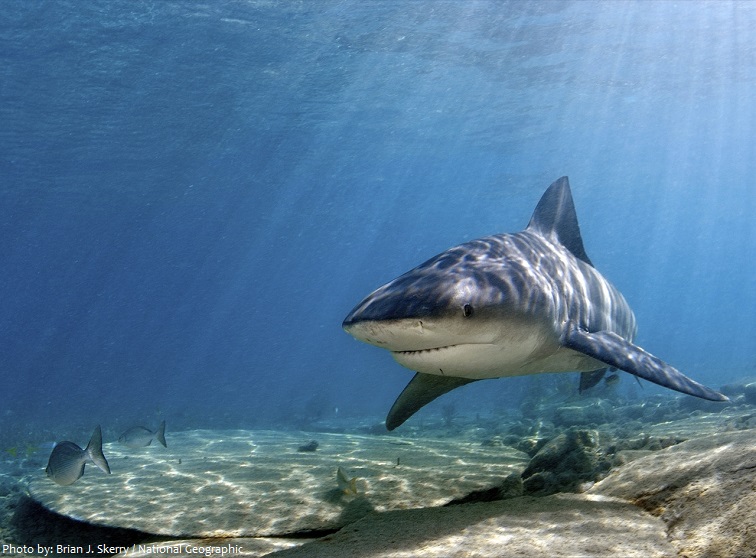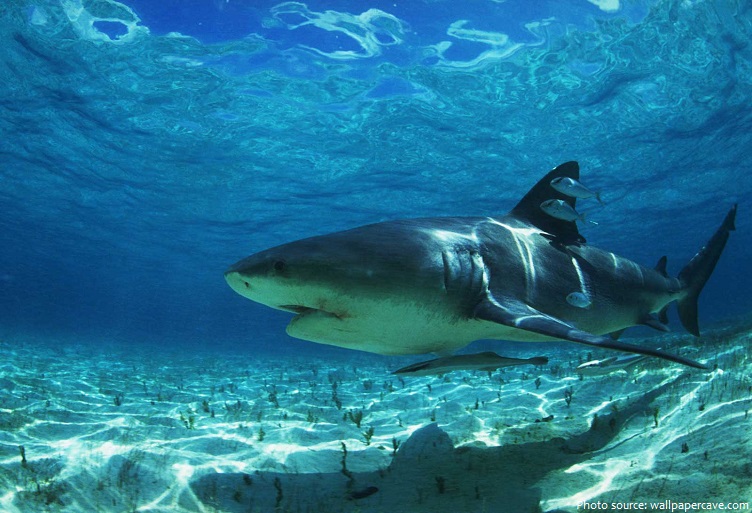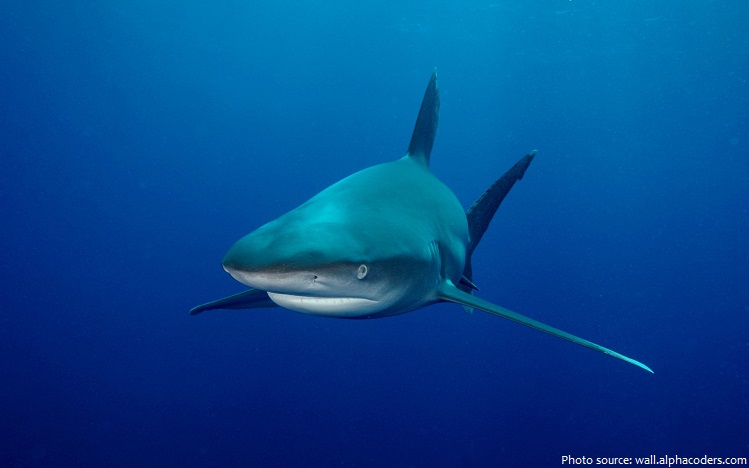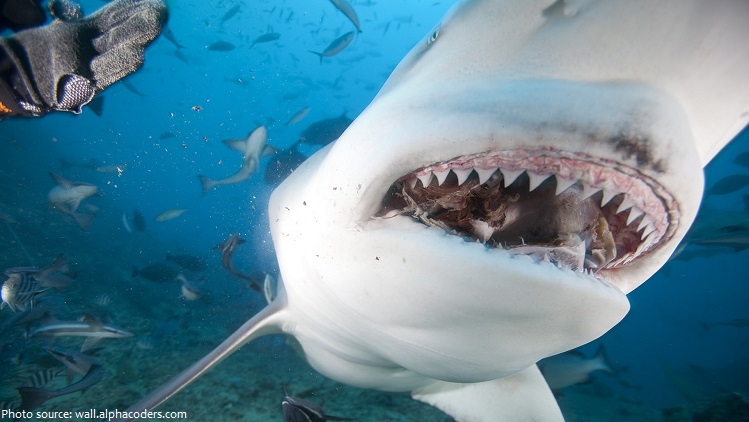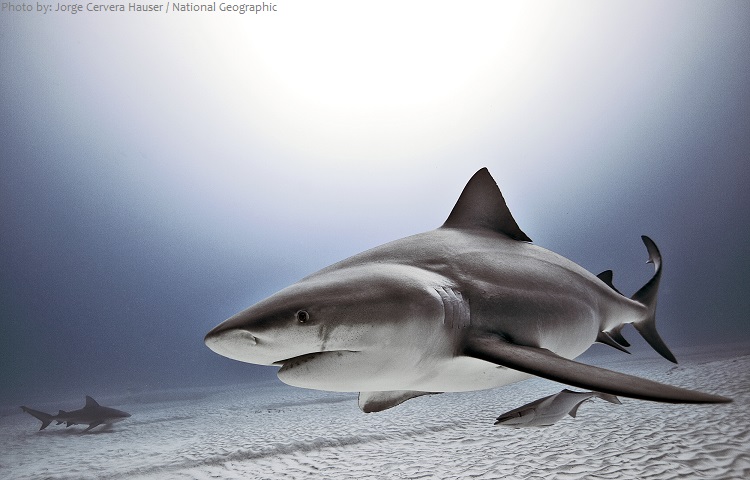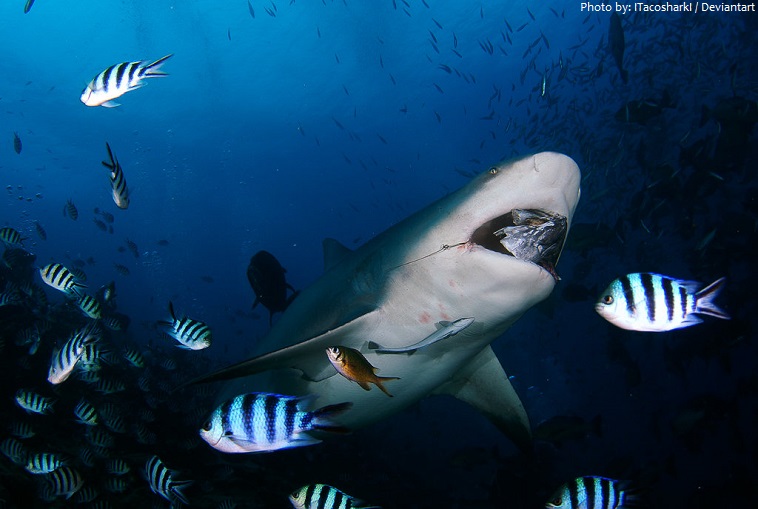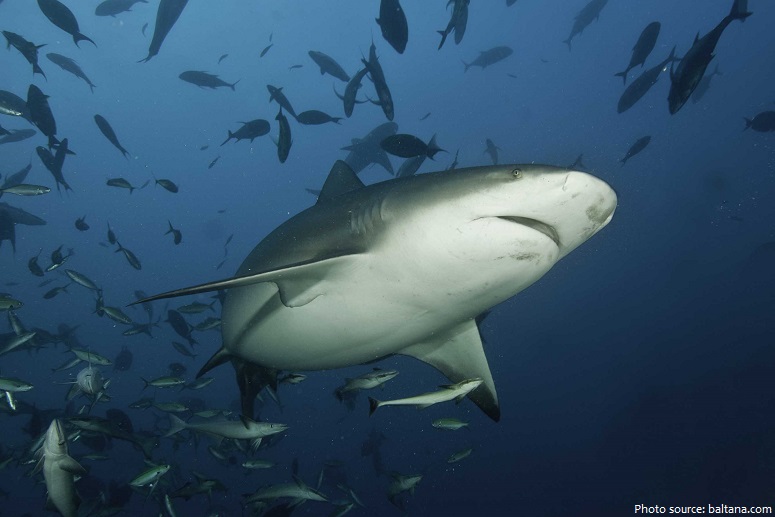The bull shark (Carcharhinus leucas) is the third most dangerous shark, after the great white and tiger shark.
Bull sharks belong to one of the most popular shark families: the requiem sharks; and is a member of the genus Galeocerdo.
The name “bull shark” comes from the shark’s stocky shape, broad, flat snout, and aggressive, unpredictable behavior.
Bull sharks are commonly found worldwide in coastal areas of warm oceans, in rivers and lakes, and occasionally salt and freshwater streams if they are deep enough.
It is found to a depth of 150 m (490 ft), but does not usually swim deeper than 30 m (98 ft).
The lifespan of bull sharks is estimated to be about 16 years.
Bull sharks are large, with females being larger than males. Adult female bull sharks average 2.4 m (7.9 ft) long and typically weigh 130 kg (290 lb), whereas the slightly smaller adult male averages 2.25 m (7.4 ft) and 95 kg (209 lb).
While a maximum size of 3.5 m (11 ft) is commonly reported, a single record exists of a female specimen of exactly 4.0 m (13.1 ft).
Bull sharks have very short snouts and the adults are a light to dark gray on top and white below.
The shark’s placoid scales are overlapping, sharp, pointed triangles that effectively protect them. These scales are thought to be hydrodynamic and assist with efficient swimming.
The bull shark can reach approximately 40 km/h (25 mph) swimming speed.
Bull sharks teeth are a broad jagged triangle up top and a thin jagged triangle along the jawline.
The bull shark has around 50 rows of teeth in its jaws, and each row has about 7 teeth, for a grand total of around 350 teeth in its mouth at any given time.
The teeth are in rows that act like conveyor belts. When one tooth is lost, the tooth behind it moves forward, sometimes as quickly as within a day, to replace the lost one. They may lose and re-grow more than 20,000 teeth over the course of its lifetime!
Bull sharks have the strongest bite of any shark species, scientists have discovered. Relative to their body size, bull sharks bite harder than other, larger predatory sharks. Adult bull sharks can bite with a maximum force equivalent to 6,000N, a study of their jaws and jaw muscles has shown.
Sharks must keep salt in their bodies to survive, and most can live only in salt water. But bull sharks have developed special adaptations—the way their kidneys function and special glands near their tails—that help them keep salt in their bodies even when they’re in freshwater.
Bull sharks often hunt in murky water, and their vision is poor compared to other sharks. The biggest advantage of hunting in murky water is they can get very close to their prey without being detected.
They hunt during the day and at night.
Bull sharks have been known to use the bump-and-bite technique to attack their prey. After the first initial contact, they continue to bite and tackle prey until they are unable to flee.
Bull sharks are usually solitary hunters, but sometimes they do hunt in pairs. They can cruise through shallow waters with quick acceleration and high aggression toward other animals and humans. They are known for its unpredictable, often agile and aggressive behavior.
Bull sharks primarily eat bony fish and other sharks, including juvenile members of their own species. Less commonly, they also eat sea turtles, crustaceans, squid, dolphins, sea birds, and swimming land mammals. There have been reports in Australia of river-dwelling bulls eating horses, and in Mozambique, they feed on hippos.
Many experts consider bull sharks to be more dangerous to humans than any other species of shark; along with the tiger shark and great white shark, are among the three shark species most likely to bite humans.
Bull sharks usually mate during late summer and early autumn in the water of river mouths. They are viviparous marine animals which born baby sharks, or pups, in much the same way as human beings and other mammals. After gestating for 12 months, a bull shark may give birth to 1 to 13 live young. They are born fully developed, about 70 cm (27.6 in) long and ready to look after itself.
Bull sharks are apex predators, so their main threat is mankind. However, they may be attacked by great white sharks, tiger sharks, and crocodiles.
The bull shark is not a species that is particularly targeted by fishing, but they are frequently caught by accident in commercial fishing operations.
When caught, their hides are sold for leather, their liver for oil, and their fins are often used in shark fin soup.
The bull shark is classified as Near Threatened by the International Union for Conservation of Nature (IUCN) Red List.
The Jersey Shore shark attacks of 1916 were a series of shark attacks along the coast of New Jersey, in the United States, between July 1 and July 12, 1916, in which four people were killed and one injured. While a great white shark was originally implicated, a few of the attacks occurred within two miles up Matawan Creek where white sharks can’t survive but bull sharks can. This was the inspiration for Peter Benchley’s novel Jaw.
Bull sharks have been seen leaping up river rapids, salmon-like, to reach inland lakes.
